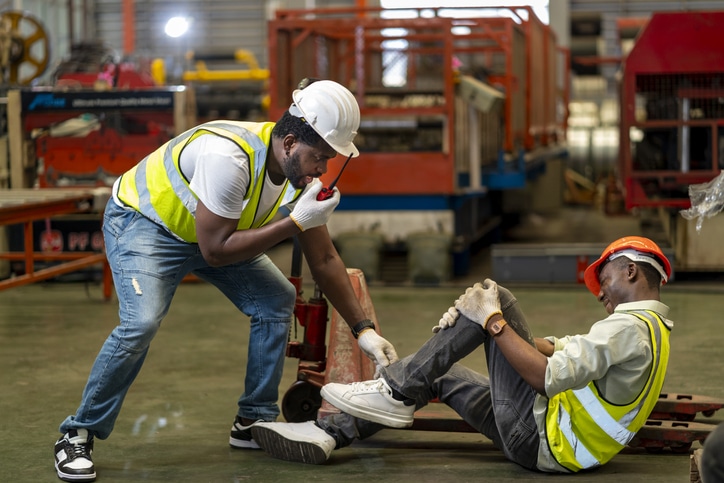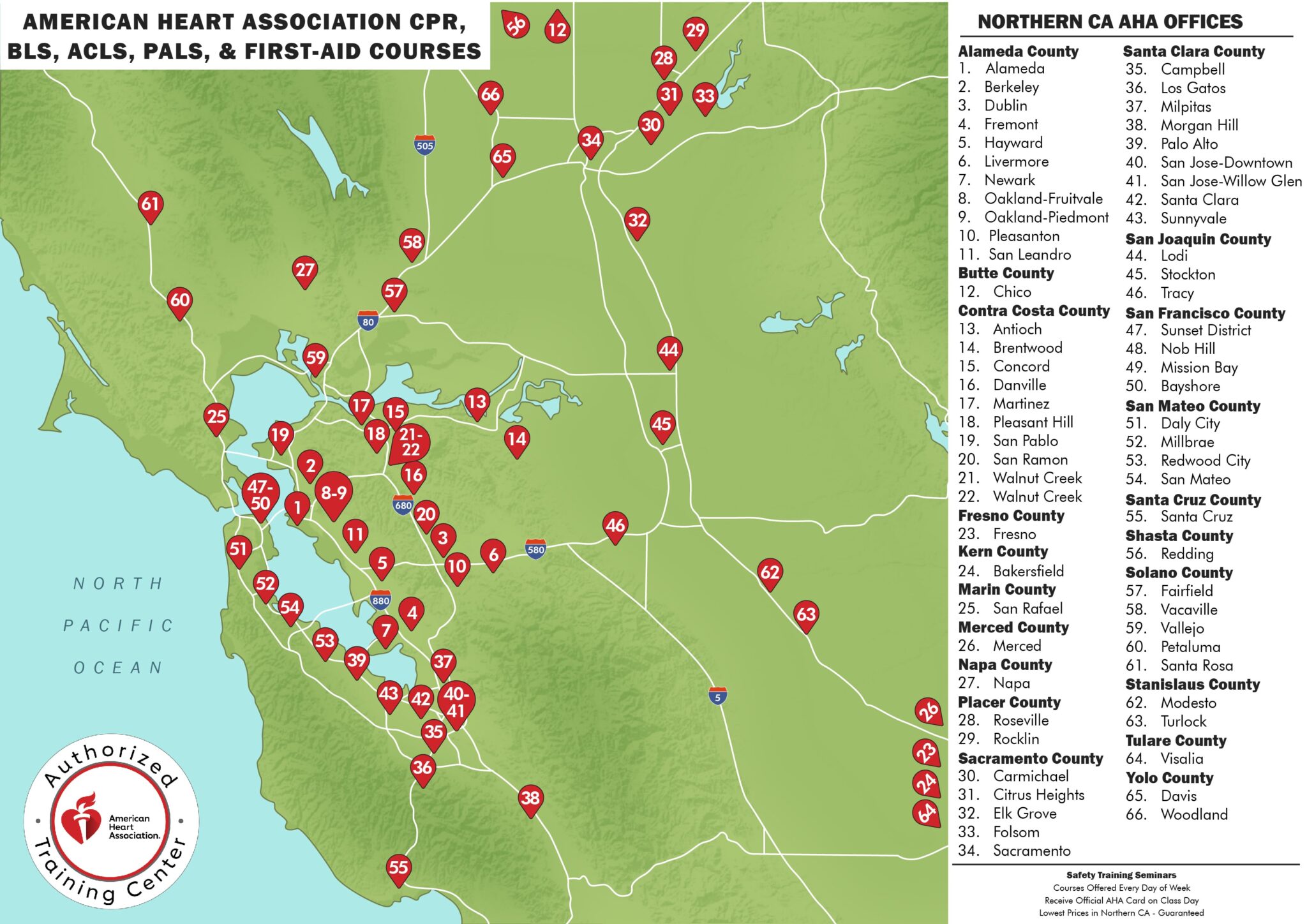
Lowest Prices in Northern CA – Classes Daily

Course Name: Heartsaver CPR, AED, and First-aid course
Online Course: 2 hours (In your home) Skills Testing: 30 minutes
Where: Over 65 CPR and First-aid testing sites across Northern CA
Description: CPR (all ages), AED, bleeding, burns, seizures, epi-pen, etc.
Price: $89 (For Safety Training Seminars certification card)
Upgrade to AHA Pediatric (Approved for child care): Extra $40
Upgrade to American Heart Association certification: Extra $40
When: CPR & First-aid classes are offered every day of the week.
Who should take this class: summer camp counselors, teachers, childcare, coaches, babysitters, construction, office workers, & general public
Card Issuance: You will receive the certification card on the day of class.
Low Price Guarantee: If you find a lower price, we will match the prices.

In Northern California, CPR and First-aid certification classes are essential components of community preparedness and safety. These classes, offered by various organizations including the American Red Cross, American Heart Association, and local healthcare providers, equip individuals with the knowledge and skills needed to respond effectively to emergencies ranging from cardiac arrest to choking incidents. This article explores the importance of CPR and First-aid certification, the offerings of these classes in San Francisco, and the impact they have on the well-being of the community.
Cardiac arrest can happen to anyone, anywhere, at any time. In the United States, approximately 350,000 out-of-hospital cardiac arrests occur annually, underscoring the critical need for bystander intervention. CPR, or cardiopulmonary resuscitation, is a life-saving technique that can significantly increase the chances of survival for someone experiencing cardiac arrest. First-aid skills, on the other hand, are crucial for addressing a wide range of injuries and medical emergencies until professional help arrives.
CPR & First-aid certification classes teach participants how to recognize and respond to various emergencies, perform CPR on adults, children, and infants, use an automated external defibrillator (AED), and provide basic first-aid care. These classes empower individuals to take action in emergency situations, potentially saving lives and reducing the severity of injuries.
CPR & First-aid certification classes in Northern California cater to individuals from all walks of life, including healthcare professionals, teachers, childcare providers, lifeguards, and lay rescuers. The curriculum is comprehensive, covering a wide range of topics such as basic life support skills, injury assessment, bleeding control, and emergency action plans.
Participants in these classes engage in hands-on training and simulations to practice their skills in a controlled environment. They learn how to assess a situation, communicate effectively with emergency responders, and provide care according to established protocols. Additionally, CPR & First-aid certification classes emphasize the importance of personal safety and infection control, ensuring that participants can respond to emergencies safely and effectively.
The impact of CPR & First-aid certification classes extends far beyond the individual participant. By equipping members of the community with life-saving skills, these classes create a network of trained responders who can intervene in emergencies until professional help arrives. This network enhances community safety and resilience, reducing the burden on emergency services and improving outcomes for those in need.
Moreover, CPR & First-aid certification classes foster a culture of preparedness and compassion within the community. Participants not only learn how to respond to emergencies but also gain a deeper understanding of the importance of helping others in times of need. This sense of community responsibility can have a ripple effect, inspiring others to seek training and contribute to a safer and more resilient community.
The American Heart Association’s (AHA) Heartsaver® First Aid CPR AED certification course is a comprehensive training program designed for individuals with little or no medical background who wish to acquire essential lifesaving skills. This course is particularly suited for those required to obtain certification for employment, regulatory compliance (e.g., OSHA), or personal preparedness. Upon successful completion, participants receive a certification valid for two years.
Course Content
The Heartsaver® First Aid CPR AED course encompasses a wide range of topics to equip participants with the knowledge and skills necessary to respond effectively in emergency situations. The curriculum includes:
First Aid Basics: Fundamental principles and practices for addressing common medical emergencies.
Medical Emergencies: Techniques for managing sudden illnesses such as heart attacks, strokes, and diabetic emergencies.
Injury Emergencies: Procedures for treating injuries like bleeding, fractures, sprains, and burns.
Environmental Emergencies: Strategies for handling situations involving extreme temperatures, bites, stings, and poisoning.
Adult CPR and AED Use: Training in performing cardiopulmonary resuscitation and using automated external defibrillators on adults.
Opioid-Associated Life-Threatening Emergencies: Guidance on recognizing and responding to opioid overdoses.
Optional Modules: Additional instruction on child and infant CPR AED use, tailored to the needs of participants.
The course is structured to ensure consistency and quality, utilizing video-based instruction and the AHA’s practice-while-watching technique. This method allows instructors to observe, provide feedback, and guide learners through hands-on practice.
Training Formats
To accommodate diverse learning preferences and schedules, the AHA offers the Heartsaver® First Aid CPR AED course in two primary formats:
Classroom Training: An instructor-led, hands-on session conducted in person. This format emphasizes skill proficiency through direct interaction with experienced instructors.Blended Learning: A combination of online coursework followed by an in-person skills session. Participants first complete the eLearning component at their own pace, then attend a hands-on session with an AHA instructor to practice and demonstrate their skills.
Both formats cover the same comprehensive content and result in the same certification upon successful completion.cpr.heart.org
Course Duration
The length of the course varies depending on the chosen format and specific modules included:
Blended Learning: The online portion typically takes between 1¼ to 3 hours to complete, depending on the learner’s pace and selected modules. The subsequent hands-on skills session requires approximately 2¼ hours.cpr.heart.org
Classroom Training: The in-person course can be completed in about 2¼ hours, including optional lessons and breaks. cpr.heart.org
These timeframes ensure that participants receive thorough instruction and ample practice to develop confidence in their abilities.
Certification Renewal
The Heartsaver® First Aid CPR AED certification is valid for two years. To maintain certification, individuals must complete a renewal course before their current certification expires. Renewal courses are designed to refresh knowledge, update participants on any changes in guidelines, and reinforce skills. They are typically shorter in duration than initial certification courses. Participants are required to present their existing certification card when enrolling in a renewal class.
Training Providers in California
California offers numerous AHA-authorized training centers where individuals can enroll in the Heartsaver® First Aid CPR AED course. Here are a few providers across the state:: Offers both classroom and blended learning formats, with options for initial certification and renewal courses. They provide training at various locations and can conduct sessions at your home or office. Prospective participants are encouraged to contact these providers directly to inquire about course schedules, fees, and specific training locations.
Importance of Training
Acquiring skills in first aid, CPR, and AED use is invaluable. Immediate and effective response in emergency situations can significantly increase the chances of survival and reduce the severity of injuries. By obtaining certification through the AHA’s Heartsaver® program, individuals empower themselves to act confidently and competently when emergencies arise, whether at work, home, or in the community.
The AHA’s commitment to providing science-based guidelines and high-quality training ensures that participants receive the most current and effective instruction available. Engaging in this training not only enhances personal preparedness but also contributes to building safer and more responsive communities.
Conclusion
The American Heart Association’s Heartsaver® First Aid CPR AED certification course offers essential training for individuals